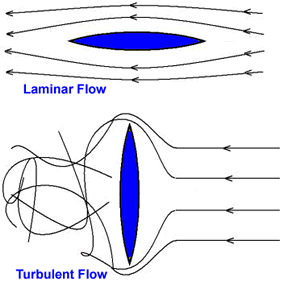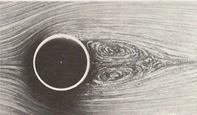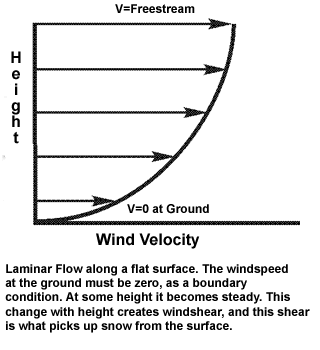[Click here to return to the page you came from!]
Laminar Flow
Also: Turbulent Flow
 Laminar flow describes fluid flow which occurs in "sheets" parallel to each other. If there is a surface nearby the flowlines typically run parallel to it. Two particles put in the flow as markers would flow parallel to each other but possibly at different speeds. In nonscientific terms laminar flow is "smooth".
Laminar flow describes fluid flow which occurs in "sheets" parallel to each other. If there is a surface nearby the flowlines typically run parallel to it. Two particles put in the flow as markers would flow parallel to each other but possibly at different speeds. In nonscientific terms laminar flow is "smooth".
When this nice, neat pattern breaks down the flow becomes turbulent. It no longer flows in parallel sheets, and two marker particles placed in the flow together would trace out paths that would be independent and largely random.
Fluid flows often change from laminar to turbulent when they go over an abrupt feature. (Such as wind going over a mountain ridgeline.)
 This photograph of fluid flowing around a cylinder from left to right shows laminar flow except behind (downstream of) the cylnder. In that area is a section of turbulent flow.
This photograph of fluid flowing around a cylinder from left to right shows laminar flow except behind (downstream of) the cylnder. In that area is a section of turbulent flow.
 In snow and avalanche studies this topic is important in understanding wind and wind transported snow as well as descriptions or models of flowing snow (i.e. avalanche dynamics). It is the shearing force of the laminar windflow along the surface that picks up snow for transport.
In snow and avalanche studies this topic is important in understanding wind and wind transported snow as well as descriptions or models of flowing snow (i.e. avalanche dynamics). It is the shearing force of the laminar windflow along the surface that picks up snow for transport.
There is a three-page sequence on Wind Transport of Snow in our Education Center. (And three additional supplemental pages available to members.) That short tutorial explains these things in more detail.
This glossary is a work in progress and is made possible by AlpenPro.



